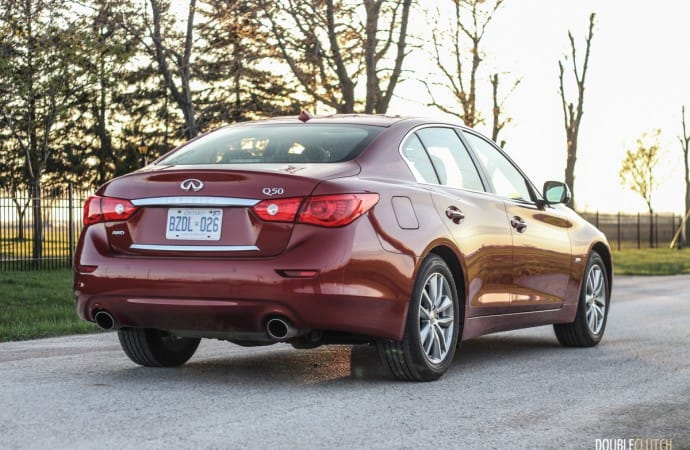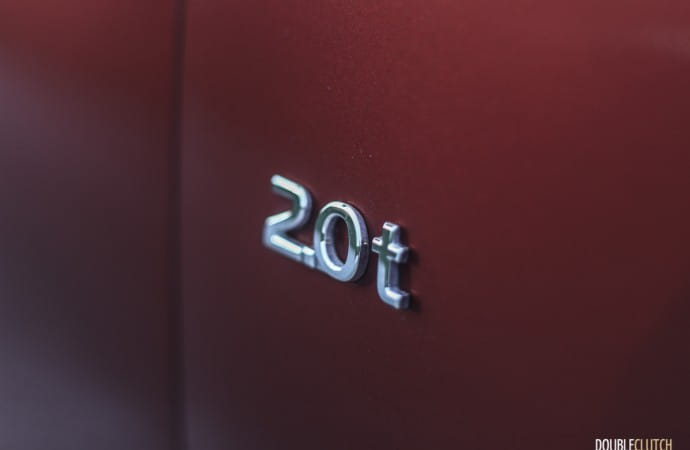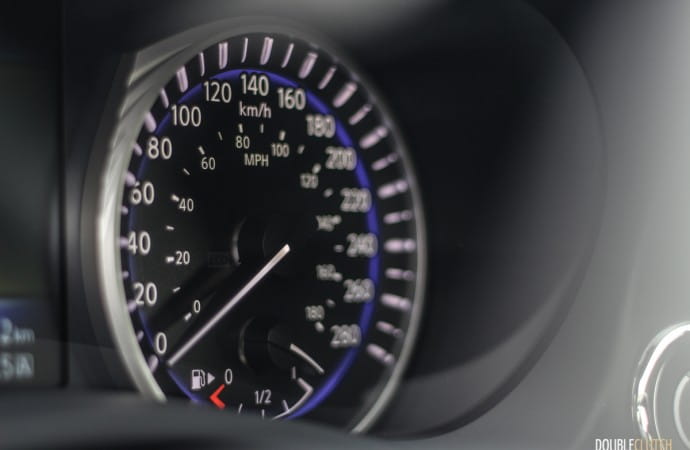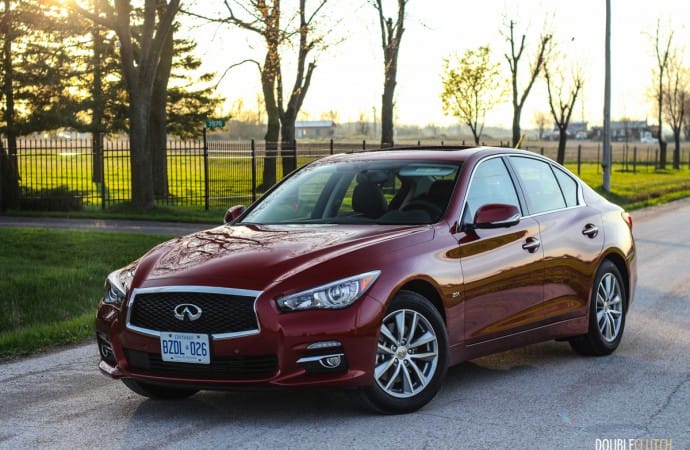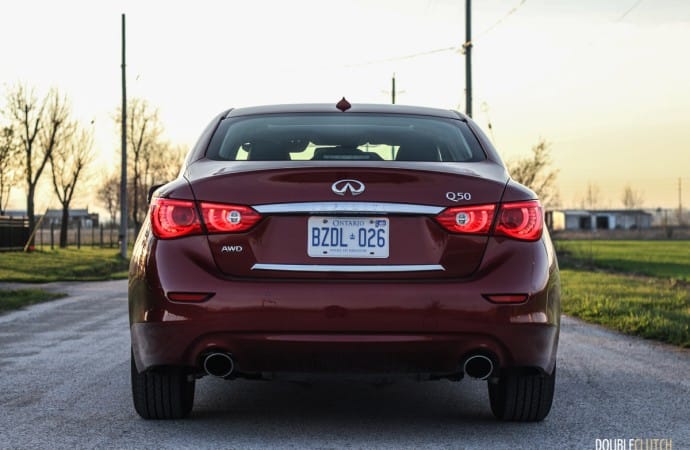Infiniti has been a strong player in the performance luxury segment since the introduction of the G35 for the 2002 model year. Though products like the forgettable G20 and I35 were decent for the time, the G35 was one of the first products that made the Infiniti brand relevant to the current generation. The name change to Q50 for the third-generation car, which debuted for 2014, lost a few fans along the way, but the car has been a competent and intelligent choice from day one. I was offered the keys to a 2016 Infiniti Q50 2.0t AWD, loaded up with Direct Adaptive Steering and a few other tech tidbits, for a week’s worth of evaluation.
Something that stands out to this purist about the Infiniti Q50 (reviewed here) is that even through redesigns, a rename, and the introduction of game-changing technology, it has not lost its original charm. The 2016 Q50 is still very obviously an Infiniti, and the styling is fresh and relevant as per 2016 standards while retaining the original cues that made the first G35 stand out. The beautifully sculpted lines and LED daytime running lights are memorable, and give the otherwise simplistic sedan design. It’s obvious that Infiniti’s design team has put in a good deal of effort into rejuvenating this car.
Previously only offered with the VQ-series 3.7L V6, the Q50 now comes with a series of new powertrains. The one most buyers will opt for is the 2.0L inline four-cylinder, sourced from Mercedes-Benz. Output for this motor is 208 horsepower at 5,500RPM, and 258 lb-ft of torque. This 2.0t is direct injected and extremely smooth, though lacking the unmistakable roar of the outgoing V6. Adding to the merits of this new base motor is a lighter aluminum block with dual overhead cams and plenty of other weight saving measures.
Though the 2014-2015 Q50 was a strong performer, it lacked a value-oriented model with an efficient engine, something that every single competitor now offers. The Q50 2.0t is aimed right at the Lexus IS 200t (reviewed here), the BMW 328i (reviewed here), and the Mercedes-Benz C 300. Whether German or Japanese, each of the Q50’s rivals offer a boosted four cylinder, so it was only logical for Infiniti to go this route. Keen auto nerds like us will recall the ill-fated Infiniti G25 from earlier this decade – the 2.0t is engineered and priced to compete with the best in the segment.
The 2.0t is mated to a seven-speed automatic transmission. This gearbox has a manual shift mode as well as automatic rev-matching on downshifts. The transmission shifts nicely, though there is some lag on upshifts, not unlike what we observed on the Mercedes-Benz GLA250 with the same unit (reviewed here). More sport-oriented trim levels offer Infiniti’s excellent column-mounted paddle shifters, but they are absent on this model. To add to Infiniti’s “performance” push, I would have liked to see paddles as standard equipment on all Q50s.
Adding to efficiency measures within the Q50 is an idle start/stop system, a first for this model. As in other offerings in the market, this setup can shut off the engine at traffic lights to save fuel. The result of all of this is a suggested fuel rating of 12.5L/100km city and 8.7L/100km highway. Our mileage over about 700km of mixed driving was 10.5L/100km on premium fuel. These numbers aren’t ideal, and significantly worse than we observed with the BMW 328i Touring (reviewed here). For comparison, the Lexus IS 200t (reviewed here) is rated at 10.6L/100km city and 7.2L/100km highway. The Infiniti’s higher rating is because despite strong efforts for weight savings and efficiency, the Q50 still weighs considerably more than its rivals.
A relevant option on our Q50 was the Direct Adaptive Steering (DAS). A controversial topic on this vehicle since its introduction, DAS is an electronic setup that eliminates a physical, mechanical connection between the steering wheel and the drive wheels. It’s a steer-by-wire system that is capable of faster response time and what Infiniti claims to be better performance altogether. The Q50’s steering is customizable through the menus, from weight to response, and is adaptive to any driver’s preference.
There is also a mechanical connection available on standby as a backup in case DAS fails. One huge tradeoff here is any sort of analog feel, though one of the benefits of DAS is the elimination of road vibrations for increased smoothness. The result is advantageous for those looking for an isolated driving experience, but a serious negative point for purists used to the old car’s sporty charm. Q50s equipped with Direct Adaptive Steering handle like they’re straight out of Gran Turismo.
Moving into the interior, the Q50 has one of the sleekest designs in its segment. The BMW’s design is functional but plain, and the Mercedes-Benz C 450 AMG (reviewed here) has a stunning interior with a few ergonomic flaws. Infiniti though, they have done it right. The dual-screen layout (8” and 7”, respectively) is responsive, though only the lower of the two screens is brilliant and high-resolution. The seats are very comfortable, and the dashboard layout is elegant and purposeful. The Q50 is a little bit roomier than the rest of its segment, thanks to some slightly larger exterior dimensions. The Acura TLX (reviewed here) is very close to the Infiniti in size.
Infotainment is controlled via either the touchscreens, or the rotary controller located within reach of the center armrest. I preferred to just touch the screens, as the system’s ease of use was incredible. One thing I would like to see improved is the upper screen – it’s still the old, low-resolution screen that Infiniti has been using since the 2007 G35 and feels very outdated. Adding to the Q50’s tech suite are features like LED fog lights and dual-zone automatic climate control.
Pricing for the Q50 2.0t with all-wheel-drive starts at $39,900. Our tester also included the Premium Package, which adds Infiniti Studio on Wheels by Bose, auto dimming mirror, leather seating (heated), InTouch navigation, power tilting steering wheel, and navigation synchronized Adaptive Shift Control. This package will add $4,000, and we would expect most buyers to opt for it. The Driver Assistance Package, for $2,000, adds driver aids which use cameras and radar to see and predict what the driver’s field of vision may not be able to. The total sticker for our test vehicle was $46,185, completely palatable considering the competition’s pricing.
The 2016 Infiniti Q50 2.0t AWD is part of a well-deserved mid-cycle refresh. It’s smack dab in the middle of one of the most exciting segments currently available. The extra bit of size goes a long way, and even despite its quirky steering setup, the Q50 2.0t has a lot to offer. The new efficiency-oriented powertrain may not be as green as it tries to be, but the lower cost of admission will undoubtedly attract some new buyers into the Infiniti family.


















